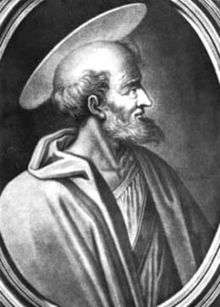Pope Simplicius
| Pope Saint Simplicius | |
|---|---|
 | |
| Papacy began | 468 |
| Papacy ended | 2 or 10 March 483 |
| Predecessor | Hilarius |
| Successor | Felix III |
| Personal details | |
| Birth name | Simplicius |
| Born | Tivoli, Western Roman Empire |
| Died |
10 March 483 Rome, Kingdom of Odoacer |
| Sainthood | |
| Feast day | 10 March |
| Venerated in | Orthodox, Catholic |
Pope Simplicius (died 2 or 10 March 483) was pope from 468 to his death in 483. He was born in Tivoli, Italy, the son of a citizen named Castinus. Most of what is known of him personally is derived from the Liber Pontificalis.[1]
Biography
After a vacancy of ten days following the death of Pope Hilarius, Pope Simplicius was consecrated on 25 February 468.[2]
Simplicius defended the decisions of the Council of Chalcedon against the Eutychian heresy. When the Eutychians rose up in Antioch and installed Petrus Mongus, Simplicius made repeated complaints for action to Basiliscus and the Emperor Leo for the restoration of the Catholic bishop; he did the same when Petrus Fullo usurped the seat of the Patriarch of Alexandria. He rehabilitated Patriarch Timotheos Solofaciolus.[3]
He labored to help the people of Italy against the marauding raids of barbarian invaders. He saw the Heruliian mercenaries revolt, depose Romulus Augustulus, the last Western Roman Emperor, and proclaim Odoacer king of Italy in 476.[4] Odoacer made few changes in the administration in Rome, leaving the city firmly in the hands of its bishop, Simplicius.
In 478, Pope Simplicius held a synod in Rome, which pronounced anathemas against eastern heretical bishops Peter Fullo, John of Apamea, and Paul of Ephesus.[5]
He worked to maintain the authority of Rome in the West.[1] He named Zeno, Bishop of Hispalis (Seville) as Papal Vicar in Spain.[6]
In 482, Bishop Gregory of Modena was consecrated a bishop against his will by Archbishop Joannes I of Ravenna. This brought the Archbishop a sharp rebuke from Pope Simplicius.[7]
Simplicius is credited with the construction of a church named Santa Bibiana, in memory of the virgin and martyr St. Bibiana. He also dedicated the Church of San Stefano Rotondo on the Celian Hill, the church of S. Andrea near S. Maria Maggiore, and a church dedicated to Saint Lawrence in the Campo Verano.[8]
According to the Carolingian liturgist, Amalarius of Metz, Pope Simplicius was the first pope to carry out consecrations at any other time than in December before Christmas. He began to confer Holy Orders in February as well.[9]
He was buried in the Basilica of St. Peter on 2 March 483. Rome was without a pope for six days.[10]
Since 1971,[11] St. Simplicius's feast day is celebrated on 10 March.[12][1]
See also
References
- 1 2 3 J. P. Kirsch, "Simplicius, Pope St." Catholic Encyclopedia. Volume XIV. New York: Appleton. 1912. pp. 2–3.
- ↑ Thiel, p. 174 §1. Jaffḗ, Regesta pontificum Romanorum, p. 77. The date is calculated, from his date of death and the length of his reign, fifteen years and seven days.
- ↑ Thiel, p. 174 §2. Loomis, pp. 97-99; 106 note 2.
- ↑ Butler, Alban.Lives of the Saints, Benziger Bros. 1894
- ↑ Karl Joseph von Hefele (1895). W. R. Clark, ed. A History of the Councils of the Church, from the Original Documents. Volume IV. Edinburgh: T. & T. Clark. pp. 26–29. In a letter which Thiel (pp. 189-192) dated to October 477, Pope Simplicius wrote to the Patriarch Acacius about what he thought should be done about the heretic bishops.
- ↑ Thiel, pp. 213-214.
- ↑ Thiel, pp. 201-202. Kehr, Paul Fridolin (1906), Italia Pontificia Vol. V: Aemilia, sive Provincia Ravennas )Berlin: Weidmann), pp. (in Latin). p. 301 no. 1. Lanzoni, Francesco (1927). Le diocesi d'Italia dalle origini al principio del secolo VII (an. 604) (Faenza: F. Lega), p. 793, no. 4. (in Italian)
- ↑ Duchesne, p. 249-250. Loomis, p. 106.
- ↑ Thiel, p. 175. Edmond Martḕne pointed out that this was the beginning of the custom of the Quattuor Temporum.
- ↑ Duchesne, Liber Pontificalis, p. 249. "Hic sepultus est in basilica beati Petri apostoli, vi non. martias. Et cessavit episcopatus dies vi." Thiel, p. 174 §1. Jaffé, Regesta pontificum Romanorum I, p. 80. Loomis, p. 107.
- ↑ Pennacchio, Maria Cristina (2000). "Simplicio, santo": "La sua memoria liturgica, indicata dal Martyrologium Romanum al 2 marzo, dal 1971 viene celebrata il 10 marzo."
- ↑ Martyrologium Romanum (Libreria Editrice Vaticana 2001 ISBN 88-209-7210-7) The date of 10 March is also a calculated one; it begins with a calculated date for the death of Pope Hilarius (29 February), and then adds the ten days of the Sede Vacante reported in the Liber Pontificalis. See Duchesne, pp. 247-248.
Sources
- Duchesne, Louis (1886). Le Liber pontificalis (in Latin). Tome premier. Paris: E. Thorin. pp. 249–251.
- Jaffe, Philippus; Loewenfeld, S. (1885). Regesta pontificum romanorum ab condita ecclesia ad annum post Christum natum MCXCVIII (in Latin). Tomus primus (secunda ed.). Leipzig: Veit. pp. 77–80.
- Loomis, Louise Ropes, ed. (1916). The Book of the Popes (Liber Pontificalis). Records of Civilization: Sources and Studies. I. To the pontificate of Gregory I. New York: Columbia University Press. pp. 105–107.
- Opera Omnia, edited by J.-P. Migne, Patrologia Latina, with analytical indexes. This link also holds the "Vita Operaque" section of the Liber Pontificalis.
- Pennacchio, Maria Cristina (2000). "Simplicio, santo". Enciclopedia dei Papi (2000). (in Italian)
- "S. Simplicii papae Epistolae et decreta," in: Thiel, Andreas (1868). Epistolae Romanorum pontificum genuinae et quae ad eos scriptae sunt, a s. Hilario usque ad Pelagium II (in Latin). Vol. I. Brunsbergae: Peter. pp. 174–220.
| Wikimedia Commons has media related to Simplicius. |
| Catholic Church titles | ||
|---|---|---|
| Preceded by Hilarius |
Pope 468–483 |
Succeeded by Felix III |

